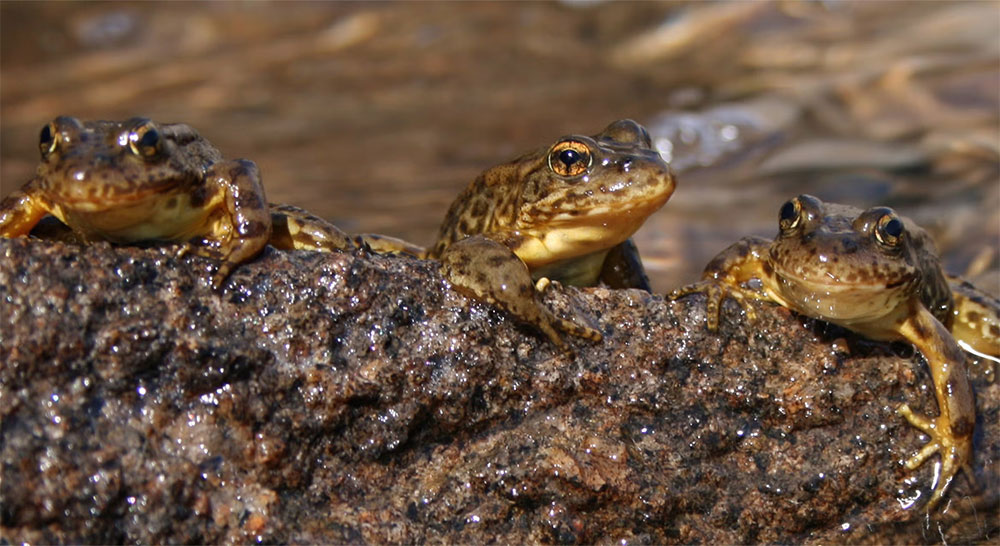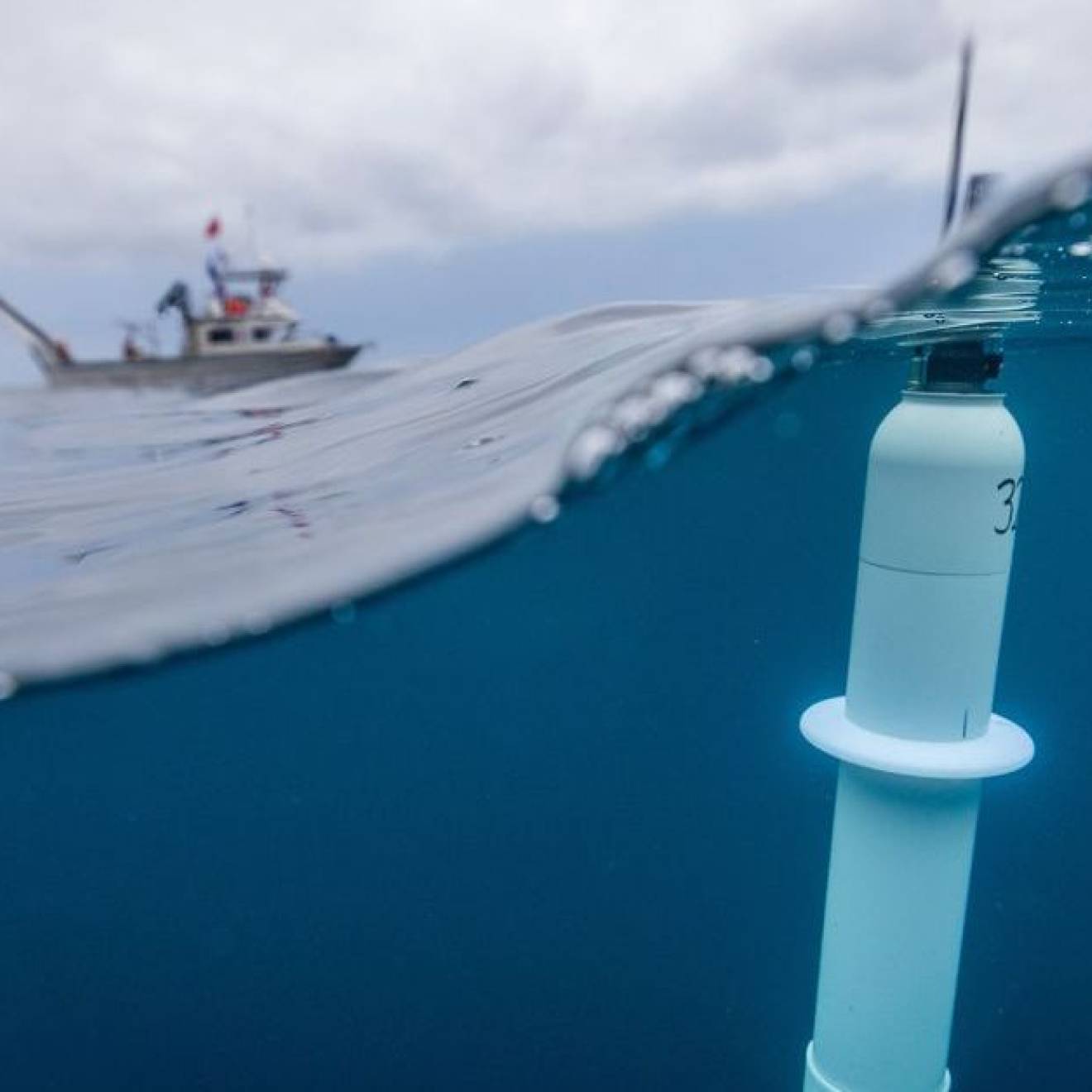The mountain yellow-legged frogs of Yosemite National Park are in an epic fight for survival. Theirs is a tale of devastation and redemption, luck and suspense, and amphibians in helicopters.
And in an era of grim headlines about the state of nature, a recent UC study about them offers a rare glimmer of hope: These frogs, which were plagued nearly to extinction by a deadly fungus just a few years ago, are now poised for a comeback.
This Earth Day, we’re celebrating stories from the past year of UC research that illustrate the resilience of life on our planet and demonstrate the power of humans to help solve problems of our own making.
Yosemite’s yellow-legged frogs bounce back
Once the most abundant amphibian in California’s high mountain lakes, the mountain yellow-legged frog has lately fallen victim to a fungus called Batrachochytrium dendrobatidis, or Bd. From its origins in Asia, Bd has spread around the globe, an accidental byproduct of “human commerce and our propensity to move things from one place to another,” says UC Santa Barbara biologist Roland Knapp, who has devoted the past 20 years to helping the species endure Bd.

The fungus kills nearly every mountain yellow-legged frog it infects, and fast: “They go from being totally healthy to being dead in a month,” Knapp says. Time and again, he’s visited alpine lakes that are chock full of yellow-legged frogs, only to come back a year later and find the lakes empty, its frogs all dead.
Amid the devastation, he also found glimmers of hope. In a few scattered lakes across the Sierra, Knapp and his fellow biologists encountered survivors. These animals had the fungus, but at much lower levels than frogs in other lakes that eventually died of it. Was there something about these particular lakes that provided protection? Or was it something about the frogs?
Starting nearly 20 years ago, Knapp partnered with the National Park Service to begin collecting frogs from survivor lakes and carrying them to lakes ravaged by Bd. For the most part, the transplanted frogs survived the move and began reproducing in their new homes. “This told us that these frogs’ advantage was not just the site,” Knapp says. “It was also the frogs themselves.”
Knapp attributes these frogs’ survival to a lucky set of mutations in their DNA, which hummed along in the background for untold generations. “Then Bd comes along,” Knapp says. “It wipes out, let's say, 99.9 percent of the population but leaves behind 0.1 percent that has the genes that allow them to resist infection.”
Within just a few years, nearly every mountain yellow-legged frog left alive in the Sierra Nevada carried resistance to Bd in its genes. “People often imagine that evolution is a long process,” Knapp says. “But in this case, it didn't take very long at all.”
Left to their own devices, the evolved frogs might gradually find their way to a few more nearby lakes. But given the obstacles they face, including non-native, frog-eating trout, an all-natural rebound would be “nothing like the wide distribution of these frogs historically,” Knapp says.
Roland Knapp
So over 17 summers, Knapp led crews of biologists in a campaign to transplant survivors to depopulated lakes (using helicopters if necessary) and monitor the results as the frogs began the slow task of repopulating their new homes. In each of a dozen new lakes, it took up to a decade of study before biologists could definitively say that the frogs had established a firm foothold. Last November, Knapp and his colleagues published the results of a long-term study concluding that humans can help Bd-resistant frogs repopulate lakes throughout Yosemite National Park.
Now, UC scientists, the National Park Service, U.S. Forest Service, U.S. Fish and Wildlife Service and California Department of Fish and Wildlife are scaling up the effort to help frogs rebound across the Sierra Nevada. “If you give these frogs half a chance, most likely they’re going to figure out a way to survive,” Knapp says.
More from UC Santa Barbara: Frog populations once decimated by disease mount a major comeback
UC Davis is home to a new run of wild salmon
A restored creek running through campus at UC Davis is now home to a self-sustaining population of salmon. Putah Creek flows through the cities of Davis and Winters en route to the Sacramento River. In the 1950s, a dam went in and choked off water downstream for much of the year, making it impossible for salmon to hatch and spawn.
In a bid to bring back native fish, a local coalition fought for rules requiring the dam operators to make sure water flowed in the creek year-round. The coalition, which included UC Davis, won its court case, and in 2000, water returned to Putah Creek. Salmon showed up in the creek by 2014, but it wasn’t clear whether they were strays from nearby hatcheries, or whether these fish had hatched in Putah Creek and returned to spawn.
A UC Davis study published in March 2025 settled the question: most fish recovered in Putah Creek were born in hatcheries, but a small contingent — 11 of the 407 studied — began their lives in this creek and survived to return and spawn the next generation of fish.
These findings are encouraging for river restoration advocates everywhere, including the coalition that’s working to bring salmon back to the Klamath River in Northern California and Oregon. Last summer, crews finished demolishing four dams on the river and its tributaries, reopening 400 miles of salmon habitat as part of the biggest river restoration in the world.
“The fact that you have Putah Creek-origin fish is a big deal,” said senior author Andrew Rypel, director of the UC Davis Center for Watershed Sciences at the time of the study. “It means we’re taking care of the water and the land the right way, and that there’s a future for fish in that place. It also shows there’s hope for other streams that are degraded.”
More from UC Davis: Restored stream supports new wild salmon run
California's most elusive mammal is photographed at last
Two UC Berkeley students made wildlife history in November, capturing the first-ever photographs of California’s Mount Lyell shrew. This tiny mammal is very small and super-active. So much so that it has to eat every few hours, or it’ll die. That explains why the shrew was California’s only known mammal that had never been trapped and photographed alive. “These traps are set overnight, and by the time they're collected in the morning, the shrew is dead in the trap,” said Vishal Subramanyan, a 2024 graduate of UC Berkeley.
This problem should be solvable, Subramanyan reasoned. All a biologist would have to do would be to hike deep into the mountains, stay awake all night shivering in cold mountain air, walking a constant circuit between traps, checking them often enough to intercept a shrew, photograph it, and set it loose within a few minutes of it hitting the trap. (Piece of cake.)
In November, Subramanyan teamed up with fellow UC Berkeley student Prakrit Jain and their friend Harper Forbes for a three-day expedition on the shrew’s namesake mountain, a 13,000-foot peak in Yosemite National Park. Through two nights of monitoring, they trapped and made photos and videos of several tiny shrews.
The Mount Lyell shrew is tough to tell apart from other shrew species that share its range. So the intrepid biologists handed their photos, footage and biological samples off to staff at UC Berkeley’s Museum of Vertebrate Zoology and the California Academy of Sciences. Results of genetic analysis came back in March, confirming that the Mount Lyell shrew had been photographed alive at last.
“Having to stay up through the night when it's 15 degrees was definitely hard, but it was also very rewarding,” Subramanyan said. “And the moments that we had with the shrews, getting to photograph them, getting to see them up close, is what kept us going.”
More from UC Berkeley: This shy California shrew avoided the camera and the limelight — until now
She spawns sea stars by the sea shore
Sunflower sea stars can grow to be a meter in diameter, sprout dozens of arms, and zoom voraciously around the ocean floor, gobbling up crabs, clams, snails and urchins in its path. They’re the biggest (and arguably baddest) sea star on Earth, long rulers of their ocean floor domain along the west coast of North America.
That all changed in 2013, when a blob of unusually warm ocean water brought a novel sea star pandemic to the Pacific coast. Sea stars infected with this disease break out in lesions before dissolving “into pile of gooey skeletal remains within days of first externally visible symptoms,” as described by typically more staid federal fisheries scientists. Within a decade of the disease’s arrival, which scientists link to climate change, nearly every sunflower sea star in California waters perished.
Now, the Birch Aquarium is part of a network of zoos, labs and aquariums up and down the West Coast that aim to save the sea stars in captivity while racing to get a handle on sea star wasting syndrome. The group includes the Aquarium of the Pacific, San Diego Zoo Wildlife Alliance, Steinhart Aquarium at California Academy of Sciences and Sunflower Star Laboratory.
As part of that effort, last February — on Valentine’s Day, natch — scientists at Birch injected a male and a female sunflower sea star with a naturally occurring hormone. The hormone caused each animal to spawn on the biologists’ schedule, making it possible for the team to predictably harvest thousands of fertilized sunflower sea star eggs.
Scientists have used some of these fertilized eggs to test new methods for preserving and transporting sea star larvae. Meanwhile, over 220 eggs hatched into baby sea stars and are now growing up at aquariums up and down the West Coast. (They call these their “Cupid babies.”) Today, these juveniles are only about 5 millimeters across, but Birch aquarist Melissa Torres says in a few years they’ll start “massively eating” and grow to the size of an extra-large pizza.
Eventually, Torres hopes to be able to release some of these babies back into the wild in California waters, though she acknowledges this cold water–loving species faces a tough draw as oceans warm. She takes hope from the California condor, one of the world’s biggest birds. “Condors were functionally extinct, but through multiple breeding programs here in Southern California and throughout the State, they’re making a comeback,” Torres said. “I just saw a baby condor this weekend.”
More from the Birch Aquarium at Scripps: Successful spawning and cross-fertilization bring hope for the critically endangered sunflower sea star
Credits for lead video: Leonie Walderich (yellow-legged frog), Vishal Subramanyan and Prakit Jain (Mount Lyell shrew), Gavin Poore (Putah Creek salmon), Birch Aquairum (sunflower sea star)


